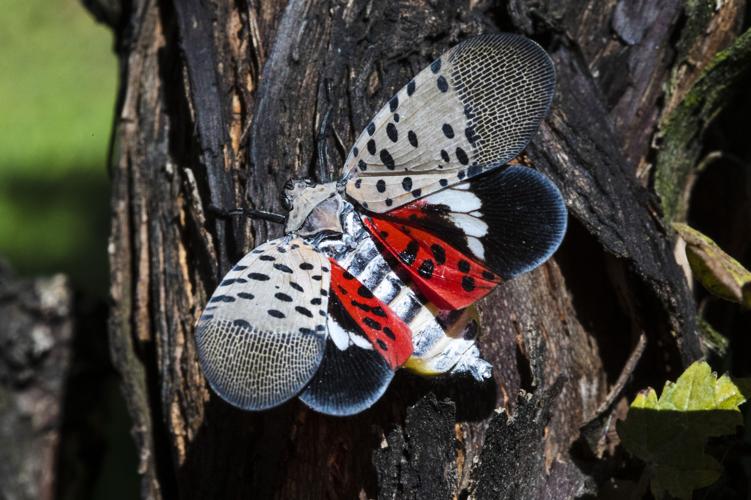Typical activities for Jackie Ritko and her team at the Disaster’s Edge Environmental Center in St. Michael include helping area students understand important issues, leading 4-H youngsters and area Scouts on nature hikes, and sometimes helping turtles live long, happy lives.
But this summer, the Disaster’s Edge crew has been battling a highly invasive species of insect – the spotted lanternfly – that has been causing havoc in southeastern Pennsylvania and has made its way to our region by hitching rides on trains.
Autumn Holdsworth, an intern at the center from Juniata College, has been catching the lanternflies in special traps.
A Forest Hills High School graduate studying fisheries and aquatics – with a minor in geology – Holdsworth has become an expert on the bad bugs.
“We’re finding some here, and they’ve been seen in places like Altoona and Lewistown,” Holdsworth said.
“When they get into the trees, they spread rapidly. That makes it hard to manage and contain.”
The center has applied for a grant to expand its spotted lanternfly crusade, which currently features 15 traps put together as part of a service project by a local Girl Scout – Savana Koval of Lilly – who is working toward her Gold Award, Ritko and Holdsworth said.
Ritko is resource conservation supervisor with the Cambria County Conservation District, and her duties include managing work at the Disaster’s Edge center near the Johnstown Flood National Memorial.
She and Holdsworth met Thursday with members of The Tribune-Democrat’s Reader Advisory Committee in a tour set up by member David Knepper, a community leader in the Forest Hills area.
Even with a turtle crawling around on the floor, and with Holdsworth holding a blue-tongued skink for guests to take pictures, the session got serious concerning the topic of the spotted lanternfly – with the hosts showing some captured insects floating in vials.
Ritko called the spotted lanternflies “generalists” – because they will attack almost any vegetation species, and are quite fond of a plant called “Tree of Heaven.”
But they have been especially harmful to vineyards and orchards.
Ritko said the bugs have been landing along the Path of the Flood Trail, riding on trains to the area and infesting rails-to-trails areas.
“They jump off the railroad cars and colonize where they land,” Holdsworth said, noting that there are usually about 80 eggs in a single egg mass.
Cambria County is among 34 in Pennsylvania that are under quarantine for the spotted lanternfly. Most are in the southeast, but Allegheny, Beaver, Blair, Huntingdon, Juniata, Mifflin and Westmoreland are also on the list. Spotted lanternflies are also found in New Jersey, New York, Ohio, Connecticut, Maryland, Delaware, Virginia and West Virginia.
Penn State Extension said the invasive insect – originally from Asia – was discovered in Berks County in 2014, and has since spread westward across the state.
“If not contained, the spotted lanternfly potentially could drain Pennsylvania’s economy of at least $324 million annually, according to a study carried out by economists at Penn State,” the extension service says.
Penn State has a hotline for those who see the insects, 888-422-3359, and suggests spraying them with an insecticidal soap such as Ortho Elementals Insecticidal Soap or Safer Insect-Killing-Soap.
Web sources say spraying the lanternflies with rubbing alcohol and water can also be effective.
“The spotted lanternfly uses its piercing-sucking mouthpart to feed on sap from over 70 different plant species,” the extension service says. “It has a strong preference for economically important plants including grapevines, maple trees, black walnut, birch, willow and other trees. The feeding damage significantly stresses the plants, which can lead to decreased health and potentially death.”
The bugs excrete a slimy substance called “honeydew” that can build up and promote the growth of fungi, also dangerous to plants. and the honeydew can create a mess when it drops onto cars and patio furniture, Penn State said.
Scientists at Penn State and elsewhere are working to determine if there is a link between the rise of the spotted lanternfly and the widely reported decline in songbird populations that prompted a call for people to stop putting out feeders this summer.
“A lot of people don’t know about them,” Ritko said of the spotted lanternflies, “but we’re trying to get the word out there so people can be on the look-out for them, because they’re so destructive.”
Chip Minemyer is the editor of The Tribune-Democrat and TribDem.com, and CNHI regional editor for Pennsylvania, Maryland, Ohio, West Virginia and North Carolina. He can be reached at 814-532-5091. Follow him on Twitter @MinemyerChip.
Chip Minemyer is the editor of The Tribune-Democrat and TribDem.com, and CNHI regional editor for Pennsylvania, Maryland, Ohio, West Virginia and North Carolina. He can be reached at 814-532-5091. Follow him on Twitter @MinemyerChip.
































Commented
Sorry, there are no recent results for popular commented articles.